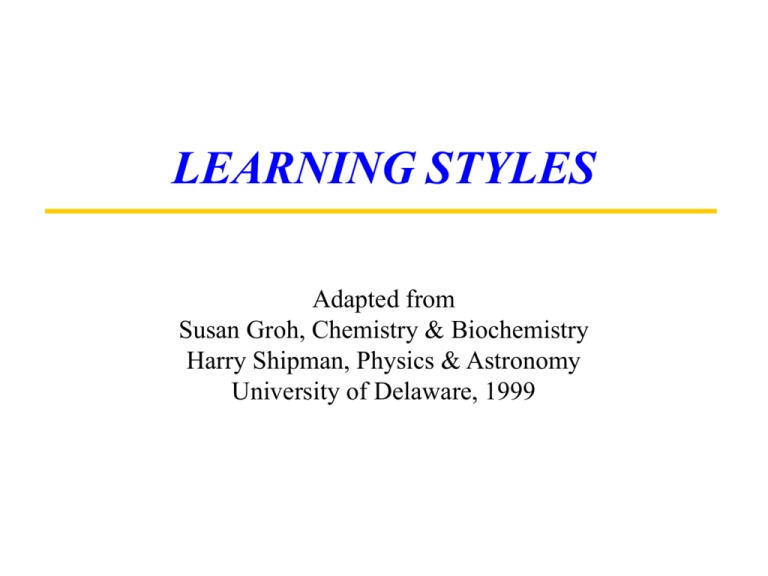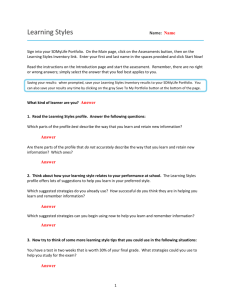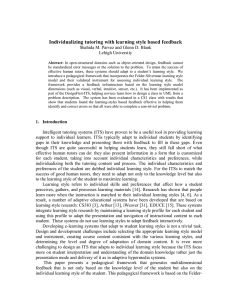LEARNING STYLES
advertisement

LEARNING STYLES Adapted from Susan Groh, Chemistry & Biochemistry Harry Shipman, Physics & Astronomy University of Delaware, 1999 What is a Learning Style? The “characteristic strengths and preferences in the ways that [learners]take in and process information” - R. Felder Why Worry About Learning Styles? STUDENT INSTRUCTOR CURRICULUM Why is There a Gap? One view of the education system is that it is a giant sorting system that selects out individuals who tend to: • learn in certain ways • teach in the ways that they’ve been taught • select out individuals who learn in the same way that their professors did Goals: Using Learning Styles • To be aware of differences in how our students take in and process information • To balance instruction so that all learning styles are addressed at least some of the time Three Learning Style Models • Myers-Briggs Type Indicator (MBTI) Isabel Briggs Myers, Gifts Differing, Consulting Psychologist Press, 1980 • Kolb Model David Kolb, Experiential Learning, Prentice Hall, 1984 • Felder-Silverman Model Felder, R.M. & Silverman, L.K. (1988) Learning styles and Teaching Strategies in Engineering Education, Engineering Education, 78, pp. 674-681 Myers-Briggs Type Indicator (MBTI) Based on Jung’s psychological types predictable patterns of behavior stemming from differences among people in • Perception: taking in information • Judging: organizing/evaluating information • Preferred domain: external or internal Opposite Preferences in ….. Perception Sensing (S) Intuition (N) Judgement Thinking (T) Feeling (F) Domain Extraversion (E) Introversion (I) Attitude Judging (J) Perceiving (P) Is the person interested mostly in ….. The external world of action, people, and materials? • EXTRAVERSION The internal world of ideas and thoughts? • INTRAVERSION after G. Lawrence, “People Types and Tiger Stripes”, 1982 Does the person tend to perceive…. Actual, concrete, and tangible data, facts, and details from observation and experience? • SENSING Concepts , “bigpicture” connections, and possibilities through insight and imagination? • INTUITION after G. Lawrence, “People Types and Tiger Stripes”, 1982 Does the person tend to make judgments…. Impersonally, based on logic, analysis and objectivity? • THINKING Subjectively, based on values and potential impact on others? • FEELING after G. Lawrence, “People Types and Tiger Stripes”, 1982 Is the person’s approach to life… Organized and managed according to preconceived plans? • JUDGMENT Spontaneous, flexible, and open to new possibilities? • PERCEPTION after G. Lawrence, “People Types and Tiger Stripes”, 1982 Myers-Briggs Types • Type is determined by the preferred mode for each of these four areas • 16 possible combinations: – – – – Thinking Types: ESTJ, ENTJ, ISTP, INTP Intuitive Types: ENTP, ENFP, INFJ, INTJ Feeling Types: ESFJ, ENFJ, ISFP, INFP Sensory Types: ESTP, ESFP, ISJ, ISTJ Keirsey Temperaments* Four broader type groups sharing many common characteristics (temperament) • SP: Artisan -observing, adaptable, tolerant • SJ: Guardian -observing, ordered, detailed • NF: Idealist -sympathetic, insightful • NT: Rational -rational, theoretical, abstract *David Keirsey, Please Understand Me, Prometheus Nemesis Book Company, 1978 Kolb Learning Style Inventory Based on 4-stage learning cycle Concrete Experience (CE) Active Experimentation (AE) Reflective Observation (RO) Abstract Conceptualization (AC) Stages in the Learning Cycle • Concrete Experience (CE): learning from feeling and personal involvement • Reflective Observation (RO): learning by watching and listening • Abstract Conceptualization (AC): learning by thinking • Active Experimentation (AE): learning by doing Learner Types and Strengths • Converger (AC+AE) • Diverger (CE+RO) • Assimilator (AC+RO) • Accommodator (CE+AE) • Practical application of ideas • Imagination and innovation • Creation of theoretical models • Action, carrying out plans Felder-Silverman Model Five Learning Dimensions: • Sensing vs. intuitive perception • Visual vs. verbal input • Inductive vs. deductive organization • Active vs. reflective processing • Sequential vs. global understanding Teaching to Learning Styles: M-B • Extraverted students • Groups, think-pair-share • Introverted students • Time for reflection • Connect material • Sensing students • Structure, organization • Hands-on activities • Intuitive students • Discovery methods • Concept maps Teaching to Learning Styles: M-B • Thinking students • Feeling students • Judging students • Perceptive students • • • • Clear objectives, fairness Collaborative groups Supportive instructor Advice on reviewing work, exam answers • Subassignments for large project • Feedback Teaching to Learning Styles: Kolb • Converger • Diverger • Assimilator • Accommodator • Decision-making, problemsolving, hands-on work • Cooperative groups, brainstorming • Model/theory creation • Design projects/experiments • Discovery learning • Activities, projects Teaching to Learning Styles: Felder • Active learners • • • Reflective learners • • Sensing learners • • • Intuitive learners • • Discussion, debate Group work Time for reflection, journals Real-world applications Hands-on activities Connections: concept maps Open-ended, speculative assignments Teaching to Learning Styles: Felder • Visual learners • • • Verbal learners • • • Sequential learners • • Global learners Diagrams, charts, movies Demonstrations Discussions, oral reports Writing projects Outlines, stepwise presentations • Topic overviews • Connections to other material




